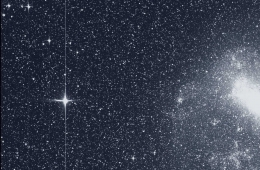Edwin Hubble, that time, wanted to prove that our galaxy isn't the one. There must be more galaxies out there, he suggested. So, he measured distance to other faraway galaxies which looked constant (doesn't move), unlike the nearer ones by comparing luminosity data.
... (Hawking, 1988)

That's what astronomers like Allan Sandage, G.A Tammann, Beatrice Tinsley, and particle physics theorists like Jim Peebles and Yakov B Zeldovich did in the 2nd half of the 20th century, searching ways to get the Hubble constant as correct as possible. From using conventional way; charting the stars and galaxies using telescope, making the list of lights and examine the red shifts, to the more advanced way using computer to do the charting, calculation and map the sight shifting. Some used different approach, e.g. using physics, measuring percent gas in the early big bang and calculating it to see whether it matches percent gas in today universe.
Jim Peebles was one who did that in the 1960's. Beside seeing the universe as a different problem (physics way, oftentimes), he and his physics club (who gathered in a little cottage after did skiing together) wanted to prove one of George Gamow's idea about cosmic microwave background, which is a leftover from the Big Bang.
But fortune apparently came to another who didn't even try to find it. It's Arno Penzias and Robert Wilson, young astronomers from Bell Labs.
"
The discovery of the cosmic background radiation was partly accident. Wilson and Penzias had been recruited in early sixties to modify a special horn-shaped antenna built to bounce signal off the "Echo" satellite so that it could send and receive microwave transmission from "Tellstar" communication satellite. Attempting to finish the work soon, something annoying bothered them. There was a constant unexplained signal when they tried to calibrate the antenna no matter how the antenna was positioned. That hum was always present (Overbye, 1991)
Turned out, it was the Big Bang's cosmic background radiation.
The temperature of it was about 3 degree above absolute zero and it is uniform in all direction of the sky. There is no special spot in the universe. If we look up from one part of the universe cosmic background's no different from another part.
That makes us think again, about the smoothness of the universe, why is it so uniform in all direction.









